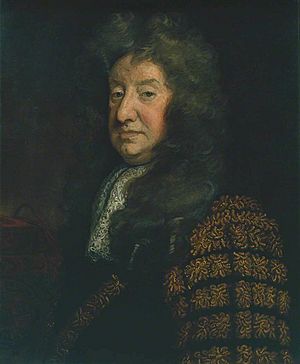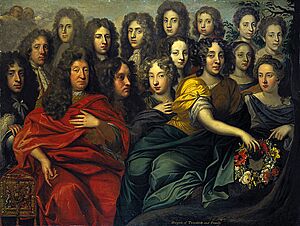John Hay, 1st Marquess of Tweeddale facts for kids
Quick facts for kids
The Most Honourable
The Marquess of Tweeddale
|
|
|---|---|

Portrait by Godfrey Kneller.
|
|
| Lord High Commissioner to the Parliament of Scotland | |
| In office 1694–1696 |
|
| Monarch | William II |
| Preceded by | The Duke of Hamilton |
| Succeeded by | The Earl of Tullibardine |
| Lord Chancellor of Scotland | |
| In office 1692–1696 |
|
| Monarch | William II |
| Preceded by | The Earl of Perth |
| Succeeded by | The Earl of Marchmont |
| Personal details | |
| Born | 13 August 1625 Yester, East Lothian, Scotland |
| Died | 11 August 1697 (aged 71) Edinburgh, Scotland |
| Spouse |
Jean Scott
(m. 1644) |
| Children | 5, including John |
| Parents | John Hay, 1st Earl of Tweeddale Lady Jean Seton |
| Military service | |
| Battles/wars | English Civil War |
John Hay, 1st Marquess of Tweeddale (born 13 August 1625, died 11 August 1697) was an important Scottish nobleman and politician. He held powerful positions, including being the Lord Chancellor of Scotland.
Contents
Early Life and Family
John Hay was born in 1625 in Yester, Scotland. He was the eldest son of John Hay, 1st Earl of Tweeddale and Lady Jean Seton. His mother passed away shortly after he was born.
In 1654, after his father's death, John became the new Earl of Tweeddale. This meant he inherited his father's title and responsibilities.
Political Career
The English Civil War
During the First English Civil War, John Hay changed his support between the King and Parliament. He first fought for King Charles I in 1642. Later, he joined Parliament's side at the Battle of Marston Moor in 1644. Four years later, he again supported the Royalists at the Battle of Preston.
Roles in Government
After the King was restored to power, John Hay was given important roles. In 1663, he became the Lord President of the Scottish Council. The next year, he was made an Extraordinary Lord of Session, which was a high legal position. He also became a Fellow of the Royal Society, a group for important scientists and thinkers.
John Hay tried to be fair to the Covenanters, a religious group in Scotland. However, his views led to him being removed from office in 1674.
Supporting William III
In 1680, he returned to a role in the Treasury. John Hay supported William III during the Glorious Revolution in Scotland. This was a major change in how the country was ruled. Because of his support, he became a privy councillor in 1689.
From 1692 to 1696, he served as the Lord Chancellor of Scotland. This was one of the most powerful legal and political jobs in the country. In 1694, he was given an even higher title: Marquess of Tweeddale.
As Lord High Commissioner to the Parliament of Scotland from 1694 to 1696, he had an important duty. He ordered an investigation into the Glencoe massacre in 1695. This was a sad event where many people were killed. He was later dismissed from his role as Chancellor in 1696 because he supported the Darien scheme. This was a plan for Scotland to set up a colony in Panama, which ultimately failed.
Personal Life
On 4 September 1644, John Hay married Lady Jean Scott. She was the daughter of Walter Scott, 1st Earl of Buccleuch. Together, they had five children, including their eldest son, John Hay, 2nd Marquess of Tweeddale (1645–1713).
John Hay, 1st Marquess of Tweeddale, passed away on 11 August 1697, at the age of 71. His portrait by Sir Peter Lely can be seen at the Scottish National Portrait Gallery.


